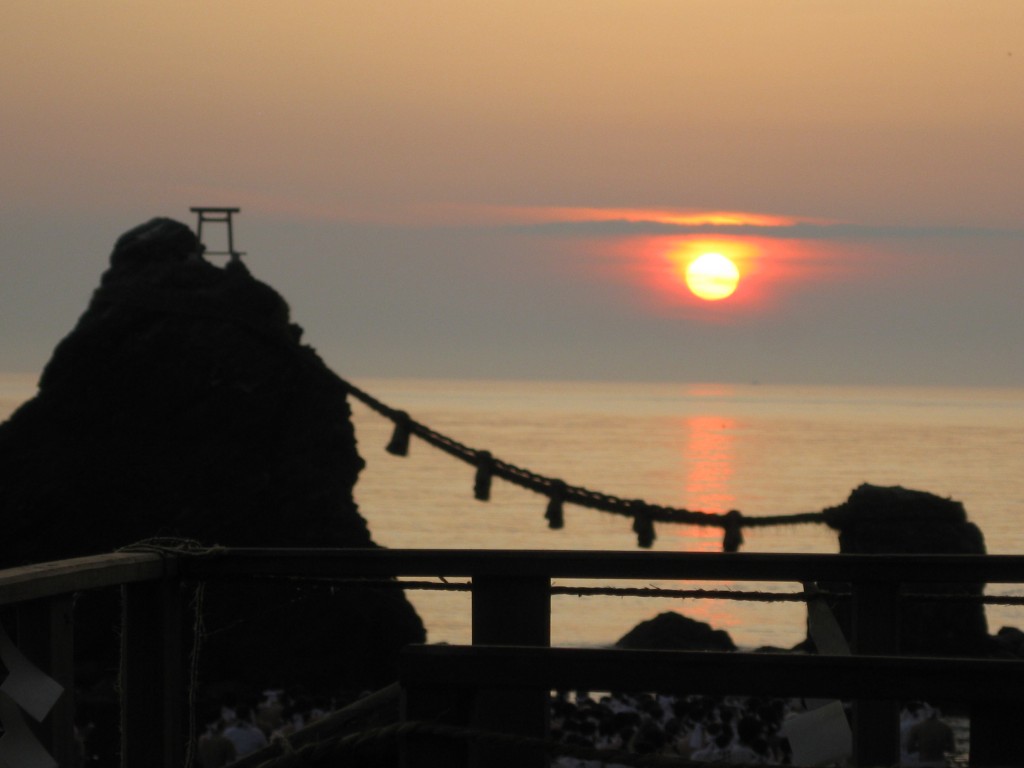Green Shinto friend Anuradha Gupta has started an excellent blog introducing Hinduism, from which it is clear how much it shares with Shnto. Indeed, as A.J. Dickinson pointed out, there may even have been direct links through the early trading routes, with Indian holy men making their way up the Chinese coast.
In this edited edition of her piece on the Sun God, Surya, Anu stresses the universal importance of the sun, raising again the interesting question of how Japan developed a female deity. Interestingly, the Shinto scholar Mark Teeuwen believes that Amaterasu may well have started life as a male. (For the full piece on Surya, and for a look at the new and recommendable blog on Hinduism, please click here.)
*****************************************************************************
The Sun enjoys a special place in the Hindu pantheon and is one of the five main deities that are meant to be worshiped daily. It is the only deity that can be seen with the naked eye.
Several hymns from the Rig Veda, invoking the Sun, are chanted as a daily ritual in many hindu households even today. I read this one today….
sarva mangalya maangalye sarva pap pranashanam
Chinta Sok prashamanam ayuvardhanam uttamam
‘The Sun Lord is auspicious and bestows auspiciousness./ He subdues grief and worries, nourishing life.’
I am sure all of us, in places further away from the equator, can identify with the above hymn. We know what a little bit of sun can do to lift our spirits and how much the lack of it can weigh us down. It is a well accepted fact that people living in warmer places tend to be happier. The ancient seers obviously knew what they were talking about. Furthermore ,they understood the impact the sun has not just on us, but the earth as well. They saw him as the mover of the solar system and the prime source of Agni ( fire).
In the earliest poems, the sun is worshipped as Agni itself, the Universal Fire. Later on he is depicted as Surya, the Sun Lord, riding a golden chariot pulled by seven white horses. The Gayatri Mantra, the most important of all mantras, also from the Rig Veda, worships the sun not just as the giver of physical light but also spiritual light. The Rig Veda, the oldest of the vedas is full of songs in praise of not just the sun but the moon, the planets, the wind, thunder and lightning, the ocean,the rivers, trees and rocks.
It is an expression of a people in awe of the world around them and I think it is the forgotten core of Hinduism. The rituals came later when the elements were enshrined as deities. Perhaps the rituals were just an elaborate ways of preserving that sense of awe and reverence.
Worshipping nature is not a primitive or superstitious act. It is a recognition of the wonder of nature, a respect for its forces which cannot be controlled and an understanding that we cannot exist without it .

Sunrise over the Meoto rocks at Ise


In view of the cave associations of Amaterasu, the Shinto sun goddess, the poem of the day by A.J. Dickinson seems peculiarly apt here…
CaveWayRise
I live in sky in light
In bloodRed streaks
In dawn come glistening
Dreaming of deep eaarth
Underground mud pregnant eyes
Flowing waters porous seas lava
Waiting unnamed unseen
For lightening for touch
For neutrinos
For molecular rivers
For cellular breath
To unclay me
The most important relation of the sun to this planet is not mentioned in the above posting: solar radiation provides the energy that permitted life to evolve on the planet and that we require daily to stay alive. The energy that powers photosynthesis is solar energy, which is captured in the plant’s molecules and used by the plant to maintain its own life. We animals intrude, harvest the plant’s structures, and eat those structures (fruit, vegetables, grains) to provide us the energy we require to stay alive. Or we animals eat animals who have used plant structures to stay alive. No matter where we are located on the food chain, the energy that keeps us alive originates in the sun. To my mind, this gift from the sun is even more precious and fundamental than its light or its cheerfulness. Plenty of reason to engage in solar reverence!
Thanks Raymond. You make a valid point. In the full post I have touched upon it but only briefly and the hymn speaks of the sun as ‘the bringer of life’ among other things. I suppose it was such an obvious fact that I did not stress upon it enough.
Besides, we are suffering from an exceptionally long and grey winter in the UK which may have blurred my focus a bit :)
Thanks very much, Raymond, for the helpful comment which makes very good sense. And may I take the opportunity to say I enjoyed your little book on Taoism, ‘Relax, you’re already home’ (Great title, by the way, which captures the same idea I was trying to express about living in Eden)….
I’m honored and happy to be part of the conversation with John and Anu and AJ about our beautiful world and our privilege to inhabit it. I look forward to learning more from them and others as we celebrate our home.